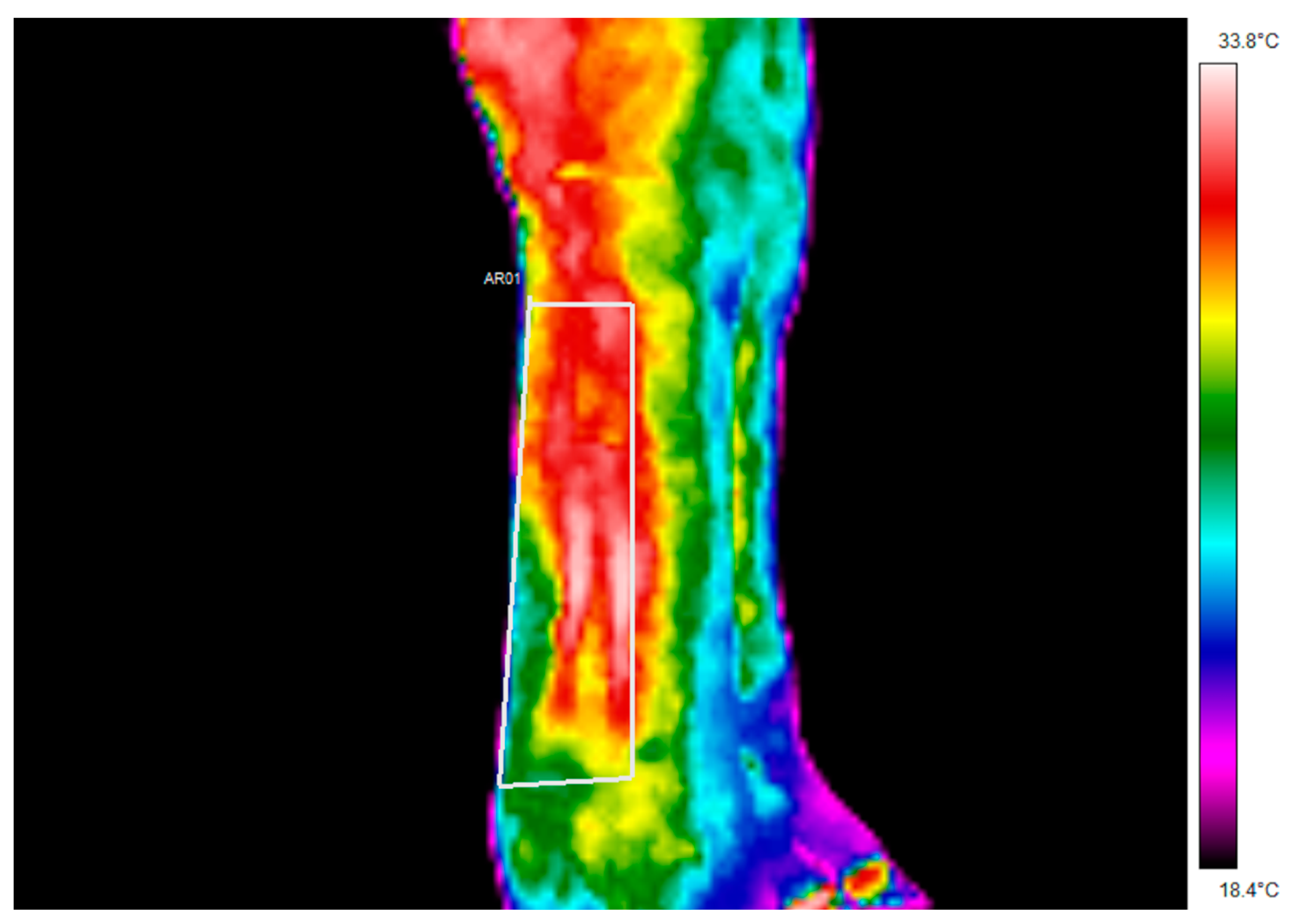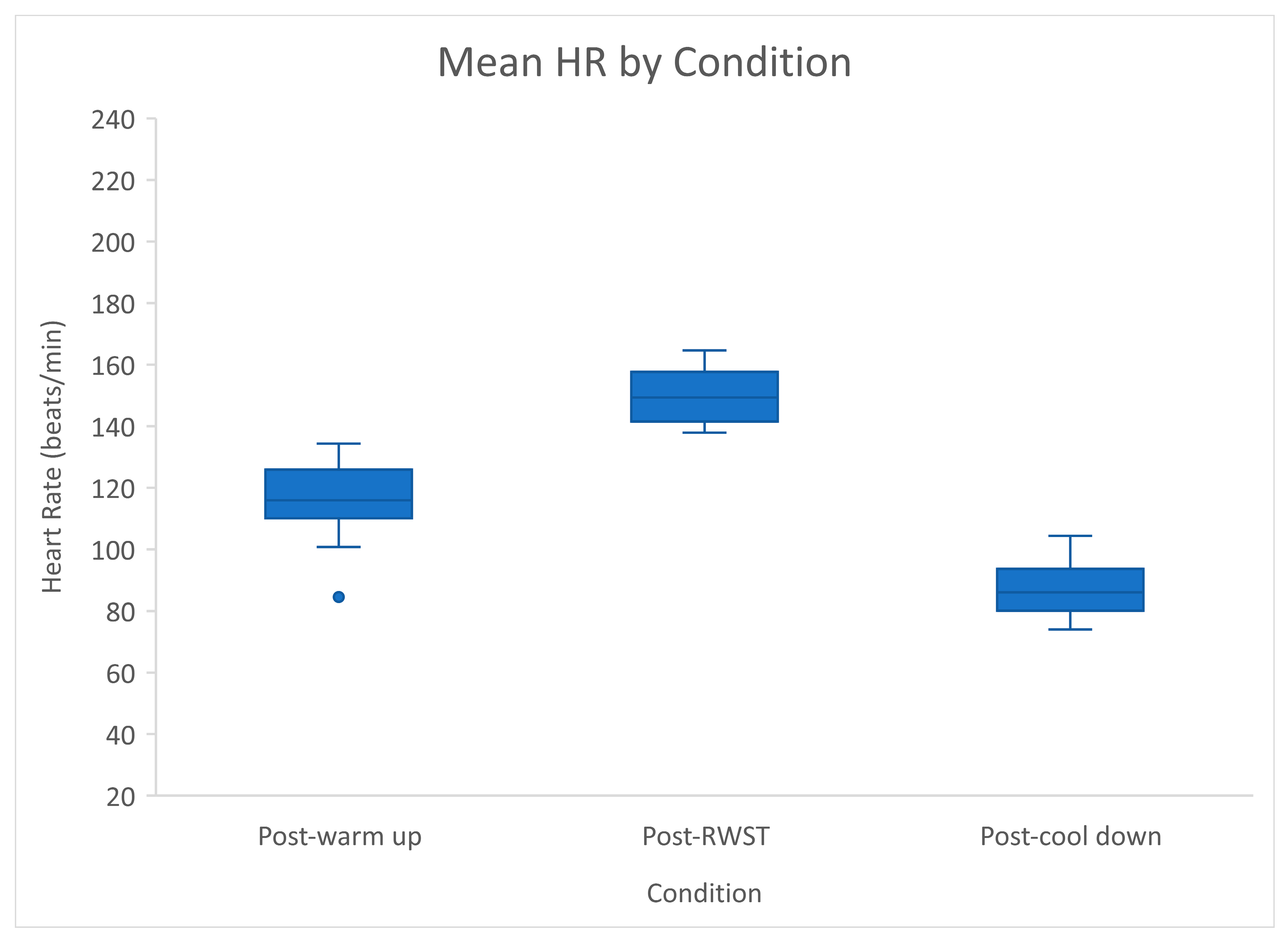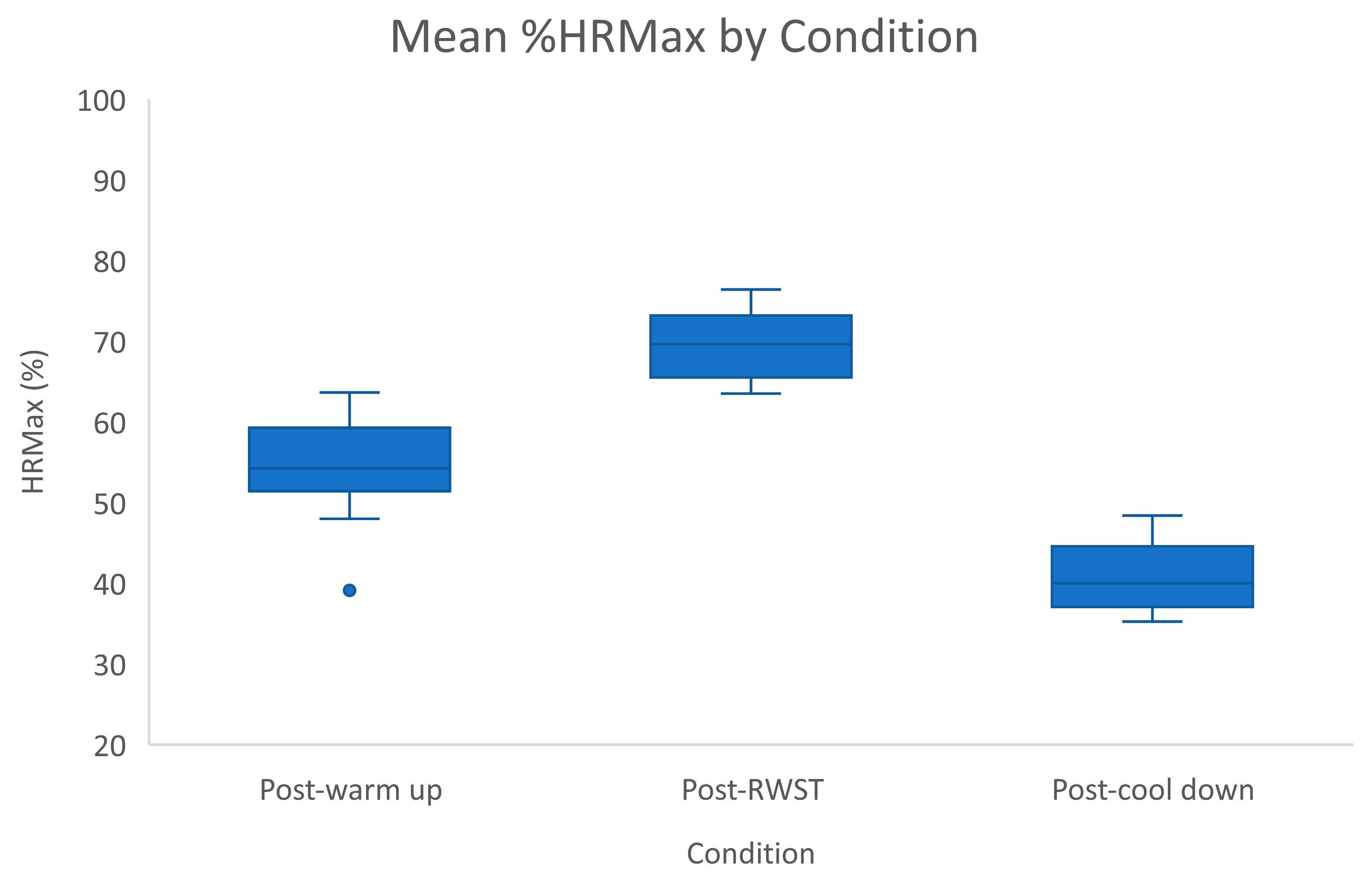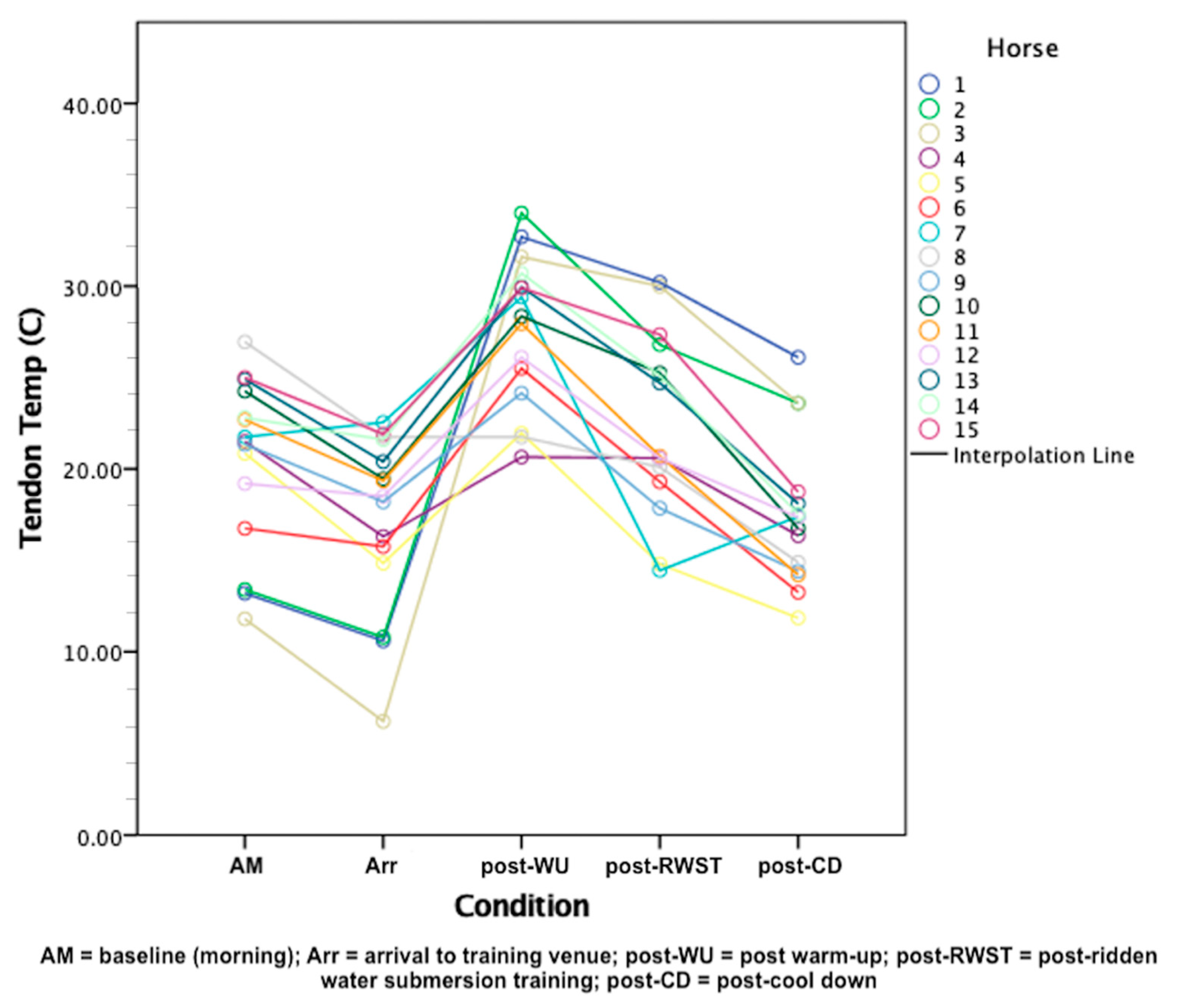A Preliminary Investigation into Ridden Water Submersion Training as an Adjunct to Current Condition Training Protocols in Performance Horses
Abstract
:Simple Summary
Abstract
1. Introduction
2. Materials and Methods
2.1. Animals
2.2. Training
2.3. Data Collection
2.4. Statistical Analysis
3. Results
3.1. Training Sessions
3.2. Cardiovascular Response to Training Sessions
3.3. Distal Limb Temperature Response to RWST
4. Discussion
5. Conclusions
Author Contributions
Funding
Institutional Review Board Statement
Data Availability Statement
Acknowledgments
Conflicts of Interest
References
- Thorpe, C.T.; Spiesz, E.M.; Chaudhry, S.; Screen, H.R.C.; Clegg, P.D. Science in brief: Recent advances into understanding tendon function and injury risk. Equine Vet. J. 2015, 47, 137–140. [Google Scholar] [CrossRef] [PubMed] [Green Version]
- Egenvall, A.; Tranquille, C.A.; Lönnell, A.C.; Bitschnau, C.; Oomen, A.; Hernlund, E.; Montavon, S.; Franko, M.A.; Murray, R.C.; Weishaupt, M.A.; et al. Days-lost to training and competition in relation to workload in 263 elite show-jumping horses in four European countries. Prev. Vet. Med. 2013, 112, 387–400. [Google Scholar] [CrossRef] [PubMed] [Green Version]
- Singer, E.R.; Barnes, J.; Saxby, F.; Murray, J.K. Injuries in the event horse: Training versus competition. Vet. J. 2008, 175, 76–81. [Google Scholar] [CrossRef]
- Murray, R.C.; Dyson, S.J.; Tranquille, C.; Adams, V. Association of type of sport and performance level with anatomical site of orthopaedic injury diagnosis. Equine Vet. J. 2006, 36, 411–416. [Google Scholar] [CrossRef] [PubMed]
- Nankervis, K.J.; Launder, E.J.; Murray, R.C. The Use of Treadmills Within the Rehabilitation of Horses. J. Equine Vet. Sci. 2017, 53, 108–115. [Google Scholar] [CrossRef]
- Muñoz, A.; Saitua, A.; Becero, M.; Riber, C.; Satué, K.; Sánchez De Medina, A.; Argüelles, D.; Castejón-Riber, C. The use of the water treadmill for the rehabilitation of musculoskeletal injuries in the sport horse. J. Vet. Res. 2019, 63, 439–445. [Google Scholar] [CrossRef] [PubMed] [Green Version]
- Greco-Otto, P.; Bond, S.; Sides, R.; Bayly, W.; Leguillette, R. Conditioning equine athletes on water treadmills significantly improves peak oxygen consumption. Vet. Rec. 2020, 186, 250. [Google Scholar] [CrossRef] [Green Version]
- Klomp, M.; Munsters, C.C.B.M.; Van Oldwitenborgh-Oosterbaan, M.M. Swimming exercise and race performance in thoroughbred racehorses. Pferdeheilkunde 2014, 30, 403–406. [Google Scholar] [CrossRef]
- Greco-Otto, P.; Bond, S.; Sides, R.; Kwong, G.P.S.; Bayly, W.; Léguillette, R. Workload of horses on a water treadmill: Effect of speed and water height on oxygen consumption and cardiorespiratory parameters. BMC Vet. Res. 2017, 13, 360. [Google Scholar] [CrossRef]
- Nankervis, K.; Tranquille, C.; Mccrae, P.; York, J.; Lashley, M.; Baumann, M.; King, M.; Sykes, E.; Lambourn, J.; Miskimmin, K.; et al. Consensus for the General Use of Equine Water Treadmills for Healthy Horses. Animals 2021, 11, 305. [Google Scholar] [CrossRef]
- Steel, C.; Morrice-West, A. A survey of trainers on the use of swimming and other water-based exercise for Thoroughbred racehorses in Australia. Comp. Exerc. Physiol. 2019, 15, 149–156. [Google Scholar] [CrossRef]
- Van Eps, A.W. Therapeutic hypothermia (cryotherapy) to prevent and treat acute laminitis. Vet. Clin. North Am. Equine Pr. 2010, 26, 125–133. [Google Scholar] [CrossRef]
- Van Eps, A.W.; Leise, B.S.; Watts, M.; Pollitt, C.C.; Belknap, J.K. Digital hypothermia inhibits early lamellar inflammatory signalling in the oligofructose laminitis model. Equine Vet. J. 2012, 44, 230–237. [Google Scholar] [CrossRef]
- Turner, T.A. Thermography as an aid to the clinical lameness evaluation. Vet. Clin. North Am. Equine Pr. 1991, 7, 311–338. [Google Scholar] [CrossRef]
- Soroko, M.; Dudek, K.; Howell, K.; Jodkowska, E.; Henklewski, R. Thermographic Evaluation of Racehorse Performance. J. Equine Vet. Sci. 2014, 34, 1076–1083. [Google Scholar] [CrossRef]
- O’Brien, C.; Marr, N.; Thorpe, C. Microdamage in the equine superficial digital flexor tendon. Equine Vet. J. 2020, 53, 417–430. [Google Scholar] [CrossRef]
- Kasashima, Y.; Takahashi, T.; Smith, R.K.W.; Goodship, A.E.; Kuwano, A.; Ueno, T.; Hirano, S. Prevalence of superficial digital flexor tendonitis and suspensory desmitis in Japanese Thoroughbred flat racehorses in 1999. Equine Vet. J. 2010, 36, 346–350. [Google Scholar] [CrossRef] [PubMed]
- Lam, K.H.; Parkin, T.D.H.; Riggs, C.M.; Morgan, K.L. Descriptive analysis of retirement of Thoroughbred racehorses due to tendon injuries at the Hong Kong Jockey Club (1992–2004). Equine Vet. J. 2007, 39, 143–148. [Google Scholar] [CrossRef] [PubMed]
- Yamasaki, H.; Goto, M.; Yoshihara, T.; Sekiguchi, M.; Konno, K.; Momoi, Y.; Iwasaki, T. Exercise-Induced Superficial Digital Flexor Tendon Hyperthermia and the Effect of Cooling Sheets on Thoroughbreds. J. Eq. Sci 2001, 12, 85–91. [Google Scholar] [CrossRef] [Green Version]
- Birch, H.L.; Wilson, A.M.; Goodship, A.E. The effect of exercise-induced localised hyperthermia on tendon cell survival. J. Exp. Biol. 1997, 200, 1703–1708. [Google Scholar] [CrossRef] [PubMed]
- Wilson, A.M.; Goodship, A.E. Exercise-induced Hyperthermia as a Possible Mechanism for Tendon Degeneration. J. Biomechmics 1994, 21, 905. [Google Scholar] [CrossRef]
- Cook, J.L.; Khan, K.M. Etiology of Tendinopathy. In Tendinopathy in Athletes; Blackwell Publishing: Oxford, UK, 2007; pp. 10–28. [Google Scholar]
- Docking, S.I.; Daffy, J.; van Schie, H.T.M.; Cook, J.L. Tendon structure changes after maximal exercise in the Thoroughbred horse: Use of ultrasound tissue characterisation to detect in vivo tendon response. Vet. J. 2012, 194, 338–342. [Google Scholar] [CrossRef]
- Munsters, C.C.; van den Broek, J.; Welling, E.; van Weeren, R.; van Oldruitenborgh-Oosterbaan, M.M. A prospective study on a cohort of horses and ponies selected for participation in the European Eventing Championship: Reasons for withdrawal and predictive value of fitness tests. BMC Vet. Res. 2013, 9, 182. [Google Scholar] [CrossRef] [Green Version]
- Redaelli, V.; Luzi, F.; Mazzola, S.; Bariffi, G.D.; Zappaterra, M.; Nanni Costa, L.; Padalino, B.; Costa, L.N.; Padalino, B.; Nanni Costa, L.; et al. The use of infrared thermography (IRT) as stress indicator in horses trained for endurance: A pilot study. Animals 2019, 9, 84. [Google Scholar] [CrossRef] [Green Version]
- Prochno, H.C.; Barussi, F.M.; Bastos, F.Z.; Weber, S.H.; Bechara, G.H.; Rehan, I.F.; Michelotto, P.V. Infrared Thermography Applied to Monitoring Musculoskeletal Adaptation to Training in Thoroughbred Race Horses. J. Equine Vet. Sci. 2020, 87, 102935. [Google Scholar] [CrossRef] [PubMed]
- Moreira, D.G.; Costello, J.T.; Brito, C.J.; Adamczyk, J.G.; Ammer, K.; Bach, A.J.E.; Costa, C.M.A.; Eglin, C.; Fernandes, A.A.; Fernández-Cuevas, I.; et al. Thermographic imaging in sports and exercise medicine: A Delphi study and consensus statement on the measurement of human skin temperature. J. Therm. Biol. 2017, 69, 155–162. [Google Scholar] [CrossRef] [PubMed]
- Dibai-Filho, A.V.; Guirro, E.C.O.; Ferreira, V.T.K.; Brandino, H.E.; Vaz, M.M.O.L.L.; de Jesus Guirro, R.R. Reliability of different methodologies of infrared image analysis of myofascial trigger points in the upper trapezius muscle. Brazilian J. Phys. Ther. 2015, 19, 122–128. [Google Scholar] [CrossRef] [PubMed] [Green Version]
- Alfieri, F.M.; Battistella, L.R. Body temperature of healthy men evaluated by thermography: A study of reproducibility. Technol. Heal. Care 2018, 26, 559–564. [Google Scholar] [CrossRef] [PubMed]
- Gómez-Carmona, P.; Fernández-Cuevas, I.; Sillero-Quintana, M.; Arnaiz-Lastras, J.; Navandar, A. Infrared Thermography Protocol on Reducing the Incidence of Soccer Injuries. J. Sport Rehabil. 2020, 29, 1222–1227. [Google Scholar] [CrossRef] [PubMed]
- Costello, J.T.; Culligan, K.; Selfe, J.; Donnelly, A.E. Muscle, skin and core temperature after −110 °C cold air and 8 °C water treatment. PLoS ONE 2012, 7, e48190. [Google Scholar] [CrossRef] [Green Version]
- Adamczyk, J.G.; Krasowska, I.; Boguszewski, D.; Reaburn, P. The use of thermal imaging to assess the effectiveness of ice massage and cold-water immersion as methods for supporting post-exercise recovery. J. Therm. Biol. 2016, 60, 20–25. [Google Scholar] [CrossRef]
- Silva, Y.A.; Santos, B.H.; Andrade, P.R.; Santos, H.H.; Moreira, D.G.; Sillero-Quintana, M.; Ferreira, J.J.A. Skin temperature changes after exercise and cold water immersion. Sport Sci. Health 2017, 13, 195–202. [Google Scholar] [CrossRef]
- Selfe, J.; Alexander, J.; Costello, J.T.; May, K.; Garratt, N.; Atkins, S.; Dillon, S.; Hurst, H.; Davison, M.; Przybyla, D.; et al. The Effect of Three Different (−135°C) Whole Body Cryotherapy Exposure Durations on Elite Rugby League Players. PLoS ONE 2014, 9, e86420. [Google Scholar] [CrossRef] [PubMed] [Green Version]
- Eddy, A.L.; Van Hoogmoed, L.M.; Snyder, J.R. The Role of Thermography in the Management of Equine Lameness. Vet. J. 2001, 162, 172–181. [Google Scholar] [CrossRef] [Green Version]
- Michelotto, B.L.; Rocha, R.M.V.M.; Michelotto, P.V. Thermographic Detection of Dorsal Metacarpal/Metatarsal Disease in 2-Year-Old Thoroughbred Racehorses: A Preliminary Study. J. Equine Vet. Sci. 2016, 44, 37–41. [Google Scholar] [CrossRef]
- Soroko, M.; Davies Morel, M.C.G.; Howell, K. The Application of Infrared Thermography in Equestrian Sport. In Application of Infrared Thermography in Sports Science; Springer: Cham, Switzerland, 2017. [Google Scholar]
- Howell, K.; Dudek, K.; Soroko, M. Thermal camera performance and image analysis repeatability in equine thermography. Infrared Phys. Technol. 2020, 110, 103447. [Google Scholar] [CrossRef]
- Soroko, M.; Howell, K. Infrared Thermography: Current Applications in Equine Medicine. J. Equine Vet. Sci. 2016, 60, 90–96. [Google Scholar] [CrossRef]
- Redaelli, V.; Bergero, D.; Zucca, E.; Ferrucci, F.; Costa, L.N.; Crosta, L.; Luzi, F. Use of thermography techniques in equines: Principles and applications. J. Equine Vet. Sci. 2014, 34, 345–350. [Google Scholar] [CrossRef] [Green Version]
- Alzola, R.; Easter, C.; Riggs, C.M.; Gardner, D.S.; Freeman, S.L. Ultrasonographic-based predictive factors influencing successful return to racing after superficial digital flexor tendon injuries in flat racehorses: A retrospective cohort study in 469 Thoroughbred racehorses in Hong Kong. Equine Vet. J. 2018, 50, 602–608. [Google Scholar] [CrossRef] [Green Version]
- Tumilty, S.; Adhia, D.B.; Smoliga, J.M.; Gisselman, A.S. Thermal profiles over the Achilles tendon in a cohort of non-injured collegiate athletes over the course of a cross country season. Phys. Ther. Sport 2019, 36, 110–115. [Google Scholar] [CrossRef]
- Soroko, M.; Henklewski, R.; Filipowski, H.; Jodkowska, E. The Effectiveness of Thermographic Analysis in Equine Orthopedics. J. Equine Vet. Sci. 2013, 33, 760–762. [Google Scholar] [CrossRef]
- Vincent, T.L.; Newton, J.R.; Deaton, C.M.; Franklin, S.H.; Biddick, T.; Mckeever, K.H.; Mcdonough, P.; Young, L.E.; Hodgson, D.R.; Marlin, D.J. Retrospective study of predictive variables for maximal heart rate (HRmax) in horses undergoing strenuous treadmill exercise. Equine Vet. J. 2006, 38, 146–152. [Google Scholar] [CrossRef]
- Cohen, J. The statistical power of abnormal-social psychological research: A review. J. Abnorm. Soc. Psychol. 1962, 65, 145–153. [Google Scholar] [CrossRef] [PubMed]
- Bitschnau, C.; Jones, J.; Haldi, J.; Laukkanen, R.; Weishaupt, M. POLAR SPORT ZONES FOR HORSES. White Pap.-Polar Sport Zones Horses 2013, 1–7. [Google Scholar]
- Allen, K.J.; Young, L.E.; Franklin, S.H. Evaluation of heart rate and rhythm during exercise. Equine Vet. Educ. 2016, 28, 99–112. [Google Scholar] [CrossRef] [Green Version]
- Mougios, V.; Deligiannis, A. Effect of water temperature on performance, lactate production and heart rate at swimming of maximal and submaximal intensity. J Sport. Med Phys Fit. 1993, 33, 27–33. [Google Scholar]
- Levine, D.; Marcellin-Little, D.J.; Millis, D.L.; Tragauer, V.; Osborne, J.A. Effects of partial immersion in water on vertical ground reaction forces and weight distribution in dogs. Am. J. Vet. Res. 2010, 71, 1413–1416. [Google Scholar] [CrossRef] [PubMed]
- Hobo, S.; Yoshida, K.; Yoshihara, T. Characteristics of Respiratory Function during Swimming Exercise in Thoroughbreds. J. Vet. Med Sci. 1998, 60, 687–689. [Google Scholar] [CrossRef] [PubMed] [Green Version]
- Arabas, C.; Mayhew, J.L.; Hudgins, P.M.; Bond, G.H. Relationships among work rates, heart rates, and blood lactate levels in female swimmers. J. Sports Med. Phys. Fitness 1987, 27, 291–295. [Google Scholar] [PubMed]
- Keskinen, K.; Komi, P.; Rusko, H. A Comparative Study of Blood Lactate Tests in Swimming*. Int. J. Sports Med. 1989, 10, 197–201. [Google Scholar] [CrossRef]
- Misumi, K.; Sakamoto, H.; Shimizu, R. Changes in blood lactate and heart rate in thoroughbred horses during swimming and running according to their stage of training. Vet. Rec. 1994, 135, 226–228. [Google Scholar] [CrossRef]
- Williams, J.; Kenworthy, K.; Jones, T.; Marlin, D.; Tabor, G. The role of heart rate monitoring to assess workload during maintenance interval training in National Hunt racehorses. J. Vet. Behav. 2019, 30, 54–60. [Google Scholar] [CrossRef]
- Soroko, M.; Howell, K.; Dudek, K. The effect of ambient temperature on infrared thermographic images of joints in the distal forelimbs of healthy racehorses. J. Therm. Biol. 2017, 66, 63–67. [Google Scholar] [CrossRef] [PubMed]
- Mendez-Angulo, J.L.; Firshman, A.M.; Groschen, D.M.; Kieffer, P.J.; Trumble, T.N. Effect of water depth on amount of flexion and extension of joints of the distal aspects of the limbs in healthy horses walking on an underwater treadmill. Am. J. Vet. Res. 2013, 74, 557–566. [Google Scholar] [CrossRef] [PubMed]
- Scott, R.; Nankervis, K.; Stringer, C.; Westcott, K.; Marlin, D. The effect of water height on stride frequency, stride length and heart rate during water treadmill exercise. Equine Vet. J. 2010, 42, 662–664. [Google Scholar] [CrossRef]
- McClintock, S.A.; Hutchins, D.R.; Brownlow, M.A. Determination of weight reduction in horses in flotation tanks. Equine Vet. J. 1987, 19, 70–71. [Google Scholar] [CrossRef]
- Mccrae, P.; Bradley, M.; Rolian, C.; Léguillette, R. Water height modifies forelimb kinematics of horses during water treadmill exercise Abstract. Comp. Exerc. Physiol. 2021, 17, 91–98. [Google Scholar] [CrossRef]
- Greco-Otto, P.; Baggaley, M.; Edwards, W.B.; Léguillette, R. Water treadmill exercise reduces equine limb segmental accelerations and increases shock attenuation. BMC Vet. Res. 2019, 15, 329. [Google Scholar] [CrossRef] [Green Version]
- Sides, R.H.; Kirkpatrick, R.; Renner, E.; Gough, K.; Katz, L.M.; Evans, D.L.; Bayly, W.M. Validation of masks for determination of O2max in horses exercising at high intensity. Equine Vet. J. 2018, 50, 91–97. [Google Scholar] [CrossRef] [PubMed]
- Plevin, S.; McLellan, J.; van Schie, H.; Parkin, T. Ultrasound tissue characterisation of the superficial digital flexor tendons in juvenile Thoroughbred racehorses during early race training. Equine Vet. J. 2019, 51, 349–355. [Google Scholar] [CrossRef] [PubMed]





Publisher’s Note: MDPI stays neutral with regard to jurisdictional claims in published maps and institutional affiliations. |
© 2021 by the authors. Licensee MDPI, Basel, Switzerland. This article is an open access article distributed under the terms and conditions of the Creative Commons Attribution (CC BY) license (https://creativecommons.org/licenses/by/4.0/).
Share and Cite
O’ Brien, C.; Pegg, J. A Preliminary Investigation into Ridden Water Submersion Training as an Adjunct to Current Condition Training Protocols in Performance Horses. Animals 2021, 11, 2629. https://doi.org/10.3390/ani11092629
O’ Brien C, Pegg J. A Preliminary Investigation into Ridden Water Submersion Training as an Adjunct to Current Condition Training Protocols in Performance Horses. Animals. 2021; 11(9):2629. https://doi.org/10.3390/ani11092629
Chicago/Turabian StyleO’ Brien, Claire, and Josephine Pegg. 2021. "A Preliminary Investigation into Ridden Water Submersion Training as an Adjunct to Current Condition Training Protocols in Performance Horses" Animals 11, no. 9: 2629. https://doi.org/10.3390/ani11092629
APA StyleO’ Brien, C., & Pegg, J. (2021). A Preliminary Investigation into Ridden Water Submersion Training as an Adjunct to Current Condition Training Protocols in Performance Horses. Animals, 11(9), 2629. https://doi.org/10.3390/ani11092629





